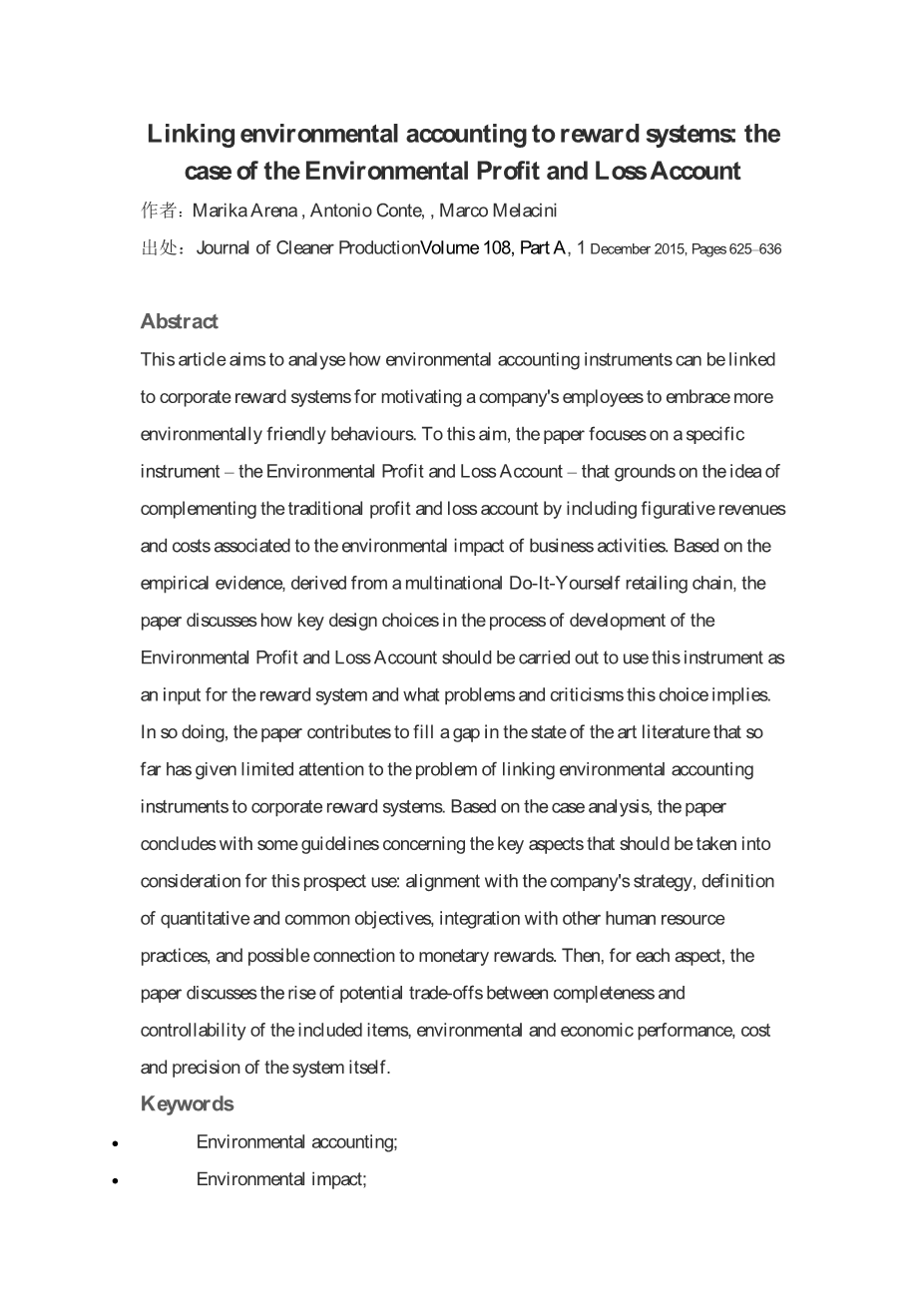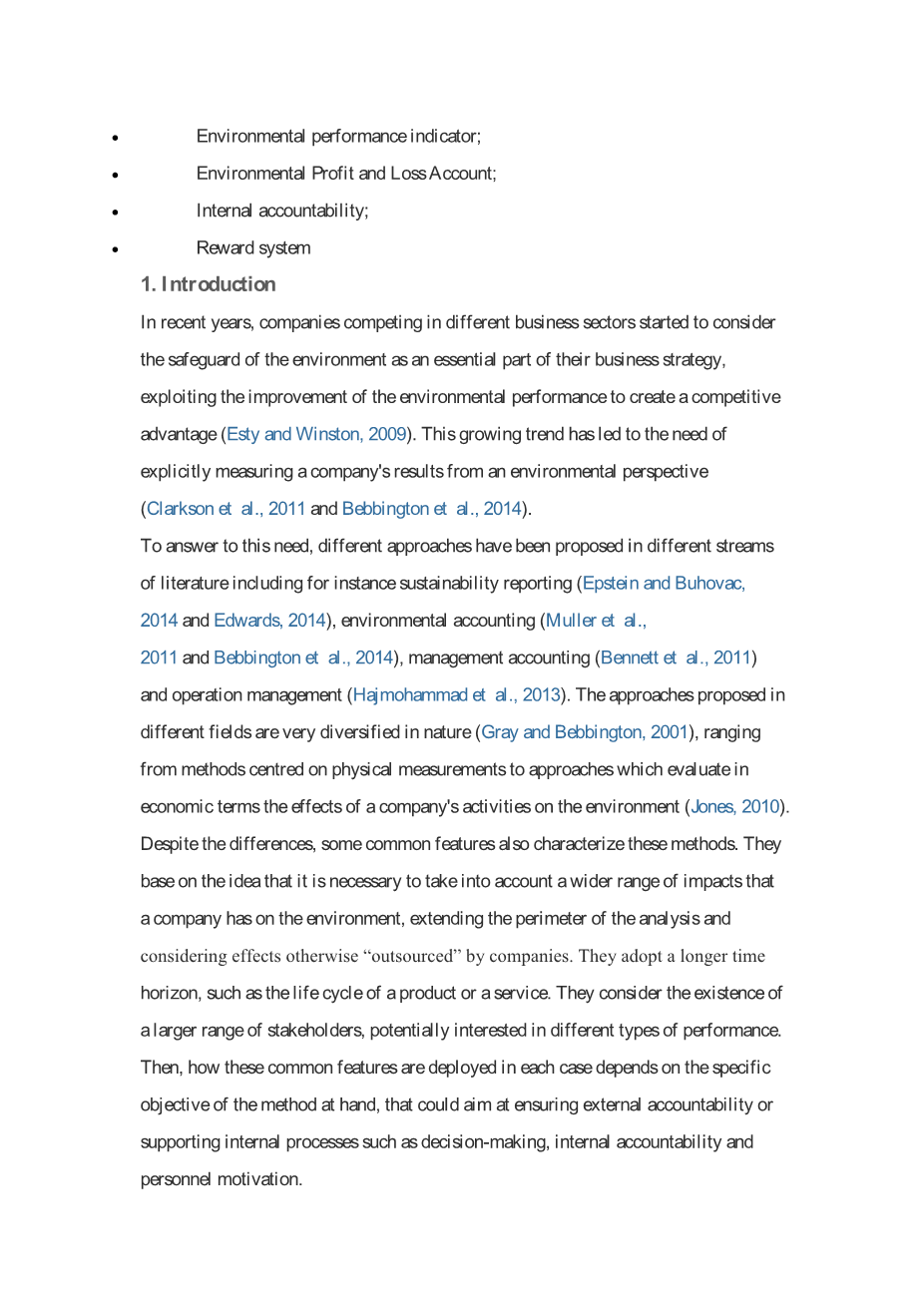

英语原文共 37 页,剩余内容已隐藏,支付完成后下载完整资料
|
题目 |
Linking environmental accounting to reward systems: the case of the Environmental Profit and Loss Account |
|
作者 |
Marika Arena , Antonio Conte, , Marco Melacini |
|
刊名 |
Journal of Cleaner ProductionVolume |
|
来源数据库 |
Journal of Cleaner ProductionVolume 108, Part A, 1 December 2015, Pages 625–636 |
|
原始语种正文 节选 |
This article aims to analyse how environmental accounting instruments can be linked to corporate reward systems for motivating a companys employees to embrace more environmentally friendly behaviours. To this aim, the paper focuses on a specific instrument – the Environmental Profit and Loss Account – that grounds on the idea of complementing the traditional profit and loss account by including figurative revenues and costs associated to the environmental impact of business activities. Based on the empirical evidence, derived from a multinational Do-It-Yourself retailing chain, the paper discusses how key design choices in the process of development of the Environmental Profit and Loss Account should be carried out to use this instrument as an input for the reward system and what problems and criticisms this choice implies. In so doing, the paper contributes to fill a gap in the state of the art literature that so far has given limited attention to the problem of linking environmental accounting instruments to corporate reward systems. Based on the case analysis, the paper concludes with some guidelines concerning the key aspects that should be taken into consideration for this prospect use: alignment with the companys strategy, definition of quantitative and common objectives, integration with other human resource practices, and possible connection to monetary rewards. Then, for each aspect, the paper discusses the rise of potential trade-offs between completeness and controllability of the included items, environmental and economic performance, cost and precision of the system itself. In recent years, companies competing in different business sectors started to consider the safeguard of the environment as an essential part of their business strategy, exploiting the improvement of the environmental performance to create a competitive advantage (Esty and Winston, 2009). This growing trend has led to the need of explicitly measuring a companys results from an environmental perspective (Clarkson etensp;al., 2011 and Bebbington etensp;al., 2014). To answer to this need, different approaches have been proposed in different streams of literature including for instance sustainability reporting (Epstein and Buhovac, 2014 and Edwards, 2014), environmental accounting (Muller etensp;al., 2011 and Bebbington etensp;al., 2014), management accounting (Bennett etensp;al., 2011) and operation management (Hajmohammad etensp;al., 2013). The approaches proposed in different fields are very diversified in nature (Gray and Bebbington, 2001), ranging from methods centred on physical measurements to approaches which evaluate in economic terms the effects of a companys activities on the environment (Jones, 2010). Despite the differences, some common features also characterize these methods. They base on the idea that it is necessary to take into account a wider range of impacts that a company has on the environment, extending the perimeter of the analysis and considering effects otherwise “outsourced” by companies. They adopt a longer time horizon, such as the life cycle of a product or a service. They consider the existence of a larger range of stakeholders, potentially interested in different types of performance. Then, how these common features are deployed in each case depends on the specific objective of the method at hand, that could aim at ensuring external accountability or supporting internal processes such as decision-making, internal accountability and personnel motivation. Clearly, when moving from one objective to the other, some modifications in the way in which a companys results are measured are needed and even the same instrument when used for different purposes should be properly adapted. In particular, when a company aims at communicating its performance to external stakeholders, all the environmental impacts should be disclosed, whether controllable or not (Unerman etensp;al., 2010). When decision-making and personnel motivation are at stake, caution is required to identify the aspects on which people could really act (Bennett etensp;al., 2011). This issue should be taken into consideration when defining the boundaries of the analysis and when selecting the environmental dimensions to be measured. This is even more critical if the system adopted for measuring the environmental performance becomes part of the reward system with an impact on the personnel remuneration (Govindarajulu and Daily, 2004). This consideration leads to the objective of this paper and its contribution to the literature. As highlighted above, in the last decades, many environmental accounting instruments were born with the aim of measuring the environmental performance. Concerning this issue, much attention has been posed to the need of ensuring the ability of the measurement system to cover different relevant performance and quantify them properly, in order to account for an entitys impact (Bebbington etensp;al., 2014). However, more limited attention has been posed to analyse how these systems should be modified when becoming part of a companys reward system to encourage a companys employees to make more environmentally friendly decisions. Most of the papers concerning this issue, in fact, recognize the relevance of integrating environmental performance in the reward system without providing any guidance about how to do that (Fernand 剩余内容已隐藏,支付完成后下载完整资料 资料编号:[153504],资料为PDF文档或Word文档,PDF文档可免费转换为Word |


